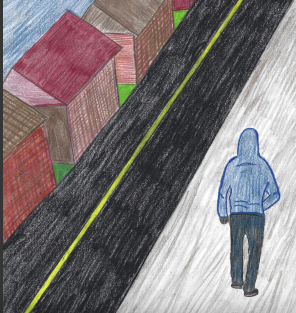When You Can’t Go Home
What It’s Like to be Young and Homeless

There are approximately 1.3 million youth living without a home on any given night in the U.S., according to research by The National Runaway Switchboard. Three years ago, Jarrod Jeffcoat, a sophomore at American University, was one of those youth.
Jeffcoat’s parents divorced when he was three and he was placed under the custody of his mother, who soon remarried a physically and sexually abusive man. When Jeffcoat turned 12 and was legally allowed to choose which parent to live with, he moved in with his father and stepmother in New Mexico. His stepmother turned out to be physically abusive as well, and attacked Jeffcoat on multiple occasions.
“It was a really unsafe, volatile home in New Mexico,” he said. “My dad knew about all of this, but he never really did anything.”
After the second time that Jeffcoat’s stepmother assaulted him, his father divorced the woman and remarried six months later.
Soon after, Jeffcoat learned his father got a job offer in Alaska, but didn’t know how seriously he was considering it. After leaving for a week-long school field trip, everything in his house had been packed up and his dad and step-mom were gone.
In a panic, he called his dad to find out what was going on. It turned out his father had accepted the new job in Alaska, and Jeffcoat was not welcome to come with him.
“I was like ‘so you’re abandoning me?’ and he said ‘yeah, in a way,’” Jeffcoat said.
At this time, Jeffcoat’s mother had fled her abusive husband and was experiencing homelessness in Virginia Beach, VA, where she soon passed away. With his mother gone, Jeffcoat decided to stay in his father’s house while it was on the market. Eventually, the house sold and the utilities shut off and Jeffcoat was forced to leave. He told his school what was going on and they connected him with Child Protective Services, who sent him to a foster care center.
Jeffcoat said he has a hard time talking about the foster care center because the conditions were bad.
“It seemed as if the kids there had been there for so long that they had wilted,” he said. “The system itself had destroyed these kids. They were my age but they were completely different than I am.”
Jeffcoat eventually left the foster care center and couchsurfed for the rest of his senior year. Now that he’s a student at AU, he has stable housing during the school year. But, during the winter and summer, he has to find a friend to stay with or work enough to pay rent on his own.
Jeffcoat, and many of the youth he lived within the foster care center, belong to the 43 percent of youth who have experienced homelessness who reported experiencing abuse before becoming unhoused.
Lindsey Kahney is a Prevention Specialist for the National Runaway Safeline (NRS), a nonprofit that connects youth in crisis with the resources they need to stay safe and off the streets. She says that most of the youth who call for help report unsafe and volatile home lives.
“Family dynamics are the main reason most youth are calling,” Kahney said. “That doesn’t necessarily mean that there’s abuse going on, but emotional abuse and physical abuse are certainly up there as some of the issues that we talk about.”
NRS helps homeless youth find services in their area, whether it be a long-term shelter, transitional housing or even just a bed for the night. One such place that NRS would direct a young person experiencing homelessness is Covenant House.
Covenant House has shelters all across the nation, but in D.C. alone it houses over 100 homeless youth every night. Aside from providing emergency and transitional housing to un-sheltered youth, Covenant House provides meals, free clothing, personal hygiene products, career pathways training and case management, according to Kyle Whitehead, Covenant House Washington’s Communications Manager.
Jeffcoat said he wishes he had access to services like case management when he was homeless.
“It’s extremely isolating because you’re quite literally on your own,” he said. “I didn’t have a support network, and that’s really damaging to someone’s mental health because I had to rely on myself to get through everything.”
Private institutions like Covenant House have saved millions of teens from living on the streets. However, those working to end homelessness know that simply providing shelter for one night isn’t enough to end homelessness. Jennifer DiNicola, the Crisis Services Manager at NRS, thinks part of the solution is community organizations working together to provide the best services they can.
“We try to do out best to collaborate with other programs throughout the country because the more we support each other the more we can support the youth we work with,” she said.
Jason Sutton, the director of Career Pathways and Supportive Services at Covenant House, believes that providing education is another key way to help homeless youth find permanent housing solutions and have safe, healthy and productive futures.
“Part of our mission is providing education and career development opportunities to the kids who stay with us,” he said. “That way we can empower them to live their best lives beyond the shelter.”






